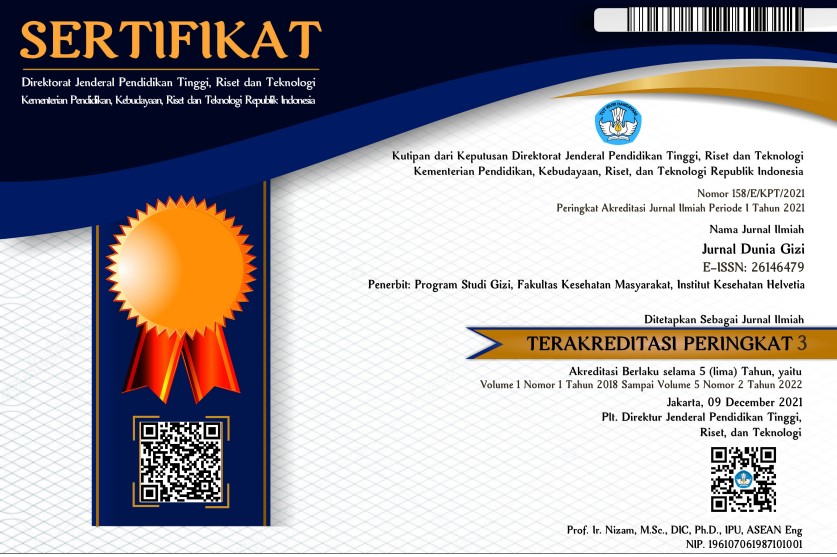Exposure of Screen Time in Relationship with Obesity in Junior High School Adolescence in Yogyakarta
Abstract
Obesity has been increasing throughout the world that also will impact to the increasing of non communicable disase realated to obesity. Obesity which is occurred since adolescence can worsen the problem because it will carry over until adult so it was necessary to prevent obesity by controlling the obesity risk factor. Some studies reveal that increasing obesity was emerged because of high screen time. Too much screen time can increase exposure of unhealthy snack and increase sedentary activity that was obesity risk factor. Objectives; to determine the relationship of screen time and obesity in adolescent in Junior High School in Yogyakarta. Material and Method; the type of research used was observational with a case control study approach. This research was conducted in 4 junior high schools in the city of Yogyakarta. The sample of this study was 120 students aged 12-15 years consisting of 60 students in the case group and 60 students in the control group selected by the proportionate random sampling method which then matched age and sex. Results; in this study it was found that there was a significant relationship between screen time of more than 2 hours/day and the risk of obesity in adolescent junior high school in Yogyakarta City (p=0.019) with an Odds Ratio of 2.6 (1.160-5.750). Higher screen time is significantly associated with a higher level of energy intake (p=0.037) with a Prevalence Ratio of 1.3 (1.025-1.638). Conclusion; it was found that there was a relationship between screen time and obesity in adolescent junior high school in Yogyakarta City.
Keywords
Full Text:
PDFReferences
Adair LS. Child and adolescent obesity: epidemiology and developmental perspectives. Physiol Behav. 2008;94(1):8–16.
Badan Penelitian dan Pengembangan. Riset Kesehatan Dasar (RISKESDAS) Tahun 2010. 2010;1–111.
Departemen Kesehatan Republik Indonesia. Laporan Hasil Riset Kesehatan Dasar (RISKESDAS) 2013. 2013.
Pusparini. Obesitas sentral , sindroma metabolik dan diabetes melitus tipe dua. Medicina (B Aires). 2007;26(4):195–204.
In-Iw S, Biro FM. Adolescent women and obesity. J Pediatr Adolesc Gynecol. 2011;24(2):58–61.
Roemling C, Qaim M. Obesity trends and determinants in Indonesia. Appetite. 2012;58(3):1005–13.
Stamatakis E, Coombs N, Jago R, Gama A, Mourão I, Nogueira H, et al. Associations between indicators of screen time and adiposity indices in Portuguese children. Prev Med (Baltim). 2013;56(5):299–303.
Martin A, Dh S, Sd S, Sproule J. Lifestyle intervention for improving school achievement in overweight or obese children and adolescents ( Review ). Cochrane database Syst Rev. 2014;(3).
Harris JL, Pomeranz JL, Lobstein T, Brownell KD. A Crisis in the Marketplace : How Food Marketing Contributes to Childhood Obesity and What Can Be Done. Annu Rev Public Heal. 2009;30:211–28.
Tarabashkina L, Quester P, Crouch R. Food advertising, children’s food choices and obesity: interplay of cognitive defences and product evaluation: an experimental study. Int J Obes (Lond). 2015;
Shochat T, Flint-Bretler O, Tzischinsky O. Sleep patterns, electronic media exposure and daytime sleep-related behaviours among Israeli adolescents. Acta Paediatr. 2010;99(9):1396–400.
Lowry R, Eaton D, Foti K, McKnight-Eily L. Association of Sleep Duration with Obesity among US High School Students. Obes. 2012;2012.
Bel S, Michels N, De Vriendt T, Patterson E, Cuenca-García M, Diethelm K, et al. Association between self-reported sleep duration and dietary quality in European adolescents. Br J Nutr. 2013;1–11.
Morselli L, Guyon A, Spiegel K. Sleep and metabolic function. Pflügers Arch J …. 2012;463(1):139–60.
Calamaro C, Park S, Mason T. Shortened sleep duration does not predict obesity in adolescents. J sleep. 2010;19(4):559–66.
Fuller-Tyszkiewicz M, Skouteris H, Hardy LL, Halse C. The associations between TV viewing, food intake, and BMI. A prospective analysis of data from the Longitudinal Study of Australian Children. Appetite. 2012;59(3):945–8.
Pearson N, Biddle SJH. Sedentary behavior and dietary intake in children, adolescents, and adults. A systematic review. Am J Prev Med. 2011;41(2):178–88.
Laurson, K. R., Lee, J. A., Gentile, D. A., Walsh, D. A., & Eisenmann JC. Concurrent Associations between Physical Activity, Screen Time, and Sleep Duration with Childhood Obesity. ISRN Obes. 2014;1–6.
Weiss A, Xu F, Storfer-Isser A, Thomas A. The association of sleep duration with adolescents’ fat and carbohydrate consumption. Sleep. 2010;33(9):1201–9.
Westerlund L, Ray C, Roos E. Associations between sleeping habits and food consumption patterns among 10-11-year-old children in Finland. Br J Nutr. 2009;102(10):1531–7.
Guyton AC, John E. Hall. Text Book of Medical Physiology. 2006.
Porterfield SP, White BA. Endocrine Physiology 3rd Ed. Philadelphia: Mosby Elsevier; 2007.
Schmid SM, Hallschmid M, Jauch-Chara K, Born J, Schultes B. A single night of sleep deprivation increases ghrelin levels and feelings of hunger in normal-weight healthy men. J Sleep Res. 2008;17(3):331–4.
Taheri S, Lin L, Austin D, Young T, Mignot E. Short Sleep Duration Is Associated with Reduced Leptin , Elevated Ghrelin , and Increased Body Mass Index. PLOS Med. 2004;1(3).
Spiegel K. Brief Communication: Sleep Curtailment in Healthy Young Men Is Associated with Decreased Leptin Levels, Elevated Ghrelin Levels, and Increased Hunger and Appetite. Ann Intern Med. 2004;141(11):846.
DOI: https://doi.org/10.33085/jdg.v1i2.3419
Refbacks
- There are currently no refbacks.

This work is licensed under a Creative Commons Attribution-NonCommercial 4.0 International License.









1.png)







.png)










